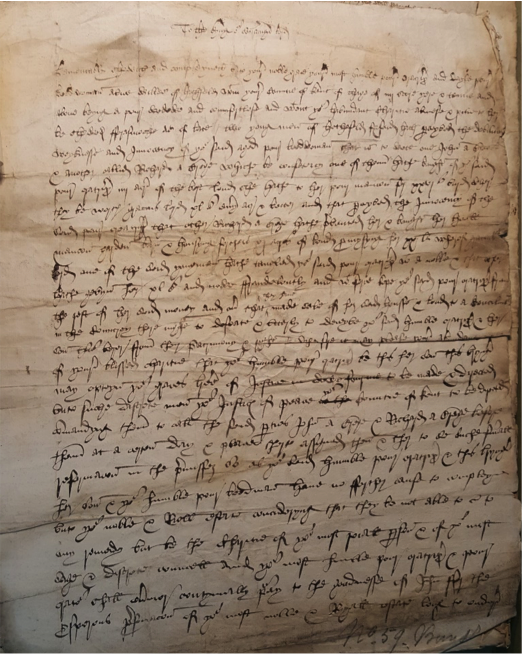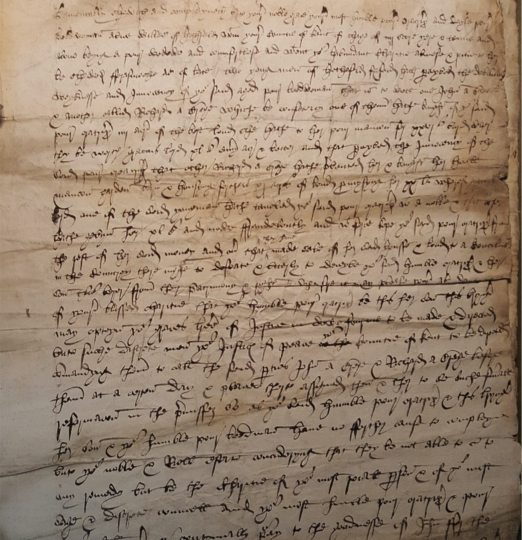Editor’s Note: Laura Flannigan’s article, “Litigants in the English ‘Court of Poor Men’s Causes,’ or Court of Requests, 1515-1525,” will appear in Law and History Review 38, no. 2 (May, 2020) and is currently available on our Cambridge University Press site. In this article, she describes the sources and her research process for the article.
For the past few years I have been working through the extant archives of the late-fifteenth and early-sixteenth-century Court of Requests. Like the courts of Chancery and Star Chamber, Requests received complaints regarding interpersonal disputes and provided extraordinary remedies on the basis of reason and conscience, under the auspices of royal councillors. However, Requests was physically separate from the Westminster-based courts of common law and conscience. Instead, it operated as a small, flexible committee of the king’s attendant household and Council, with all its procedures initiated by petitions for justice submitted there by litigants. Requests was therefore especially personalised to the king and responsive to his subjects. By the Elizabethan age its conception as a royal jurisdiction for ‘poore miserable persons causes’ was complete. In the centuries following the Court’s dissolution in 1643 its historical significance has typically been encapsulated in the double-edged shorthand ‘poor man’s Chancery’.
Although we might expect that Requests offers a chance to examine the engagement of the very poorest with the central justice system, close analysis of the Court’s rich surviving records has been in short supply over the last century. The principal exception is Tim Stretton’s work on Women Waging Law in the Elizabethan Requests, where the origins and strategies of the Court’s clientele – the ‘temporarily poor’ – was sketched out.[1] My aim was to produce a litigant demography for the early Requests with comparison to the other main conciliar courts and to assess how far the realities of this tribunal aligned with its historical reputation. The findings underscored the limitations of conciliar court records and existing methods of analysis for drawing out litigant profiles, especially where the ‘poor’ are concerned.

The tried and tested means of identifying the broad body of litigants within a given legal tribunal is to record and count the descriptors applied by/to them within the records. The Requests archive consists of bound books of registers and decrees (The National Archives of the UK, REQ 1) and a collection of loose pleadings (TNA REQ 2). I examined all the surviving documents in these classes that can be dated to the decade 1515 to 1525, a busy and well-recorded period in the Court. Several observations and conclusions about litigant identification emerged. Analysis of both sets of records suggested that Requests’ petitioners were most often clergymen, craftsmen, merchants, and widows. However, there were marked differences in the way that the clerks described parties in the books and how litigants described themselves in their pleadings. It has also been suggested that churchmen were potentially over-represented in court records, since their office was the ‘very essence of [their] self-definition’ and perception by others.[2] The same might be said for widows, the single most common group of petitioners across all the records studied here. After all, ‘widow’ was a widely used term of address in English law and society, and women otherwise made up only around ten percent of all plaintiffs in the court in this period. Hence we may suspect that some of these findings reflect trends in recording habits, not litigation patterns.
“In all, tracing the poor in legal archives – even those of the supposed ‘poor man’s court’ – is complicated by contemporary self-fashioning and, consequently, by the lack of static societal distinctions preferred by historians.“
Nevertheless, if we take social descriptors like these at face value, it appears that Requests’ petitioners were of a lower status than those served in the other royal conscience courts, where the ‘middle ranks’ and ‘upper echelons’ predominated according to Tim Haskett’s research on the late-medieval Chancery and John Guy’s study of Star Chamber in the age of Thomas Wolsey.[3] The discrepancy between petitioners and their opponents was also especially wide in Requests: this was a tribunal that pitted lowlier clergy, craftsmen, small-time landowners and widows against higher-ranking gentry (usually landlords), powerful ecclesiastics, and corrupt officials. Although this analysis produces a picture of Requests’ litigant demography more sophisticated than the above/below gentleman binary typical of socio-legal histories, each of the social groupings that I applied (‘civic and administrative officials’, ‘clergy’, ‘crafts, trades, and services’, ‘landed status’, ‘professionals’, and ‘miscellaneous’) could no doubt have contained people of wildly diverse economic statuses. ‘Crafts, trades, and services’, for example, includes everyone from those rural artisans who were worth as little as £3 per year, uncovered in Alexandra Shepard’s recent research with church-court depositions, to those wealthy merchants and guildsmen of early-Tudor London described by John Oldland.[4] The Requests records give few concrete indicators of where any given individual sat on this spectrum.
There is another, more substantial gap in the dataset emerging from the Requests archive – one that is especially telling as to the perception of poverty at law more generally. In ninety percent of the order-book entries and fifty-seven percent of the sampled petitions from the decade under investigation, petitioners went without any clear social identification. The same absence of information was present (though unaddressed) in Haskett’s study of Chancery petitioners and in Guy’s work on Star Chamber, too. We know from Shepard’s research that virtually everyone in early-modern England could estimate their worth in money and property, and could recite it when called as witnesses before the civil and church courts. But litigants in the conciliar courts were not required to declare their status, and so they often simply chose not to. Did these people have no defined occupation or rank, in their own eyes and those of the Court’s clerks? Or were they obscuring their status in order to pass themselves off as poorer than they really were? In most instances the Requests records, with their fairly formulaic book entries and petition forms, provide no firm answer either way.
Some answer to this, and some explanation for Requests’ historical reputation, emerges when the quantitative data is supplemented with qualitative analysis of the records, and by keeping the institutional context of Requests in mind. All petitions to Requests in this period were addressed directly to ‘the king our sovereign lord’ rather than to any presiding judge, and made entreaties to the monarch’s own mercy, charity, and pity, prayers for his long life, and requests for his ‘gracious letters of high commandment’. What’s more, almost all of the petitions in my sample – even those in which the petitioner offered other, more definitive means of identification – justified recourse to these elements of the king’s justice on the basis of generalised, debilitating social disadvantages as much as by any jurisdictional technicality. Many wrongs expressed in the Court were framed as exertions of ‘extort power’ by opponents against the status quo of long-standing local landholding structures, previous legal proceedings and, allegedly, against people with no easy means of holding them to account.
A particularly vivid and illustrative example to this effect is the plea of William Holt of Worcestershire, from 1517 (REQ2/3/137). Holt’s petition to Requests alleged that his opponent in a dispute over a ‘dwelling place’, the esquire Richard Griswold, was ‘a man of grett londes havyng many kynsmen frends and alyans and also of gret mayntenaunce within the saide Countye of [Worcester] and yor said Oratoure [is] but pore and hath nother frendes alyans nor acquentans within the same shere is not able to sue nor trie with the said Ric. at the Comon Lawe’. Here and in many other petitions in my sample the plaintiff’s poverty was relative to that of the defendant,and was defined according to various elements of social cachet beyond simple economic worth. These factors meant that for many, like Holt, the local common-law courts were not felt to be viable or impartial venues for redress. Indeed, many petitioners described how their opponents had already had such processes quashed. If they pursued their suit in Requests to final determination, petitioners could expect to receive a judgment resembling an arbitration, tailored to the specific circumstances of their case and the nebulous ideal of ‘right and good conscience’ rather than the letter of the law, but which was formally endorsed by the king. Undoubtedly this was all part of general battle of attrition waged between disputants across various law courts, which had sometimes spanned multiple decades and generations.
In all, tracing the poor in legal archives –
even those of the supposed ‘poor man’s court’ – is complicated by contemporary
self-fashioning and, consequently, by the lack of static societal distinctions preferred
by historians. Yet the level of ambiguity and flexibility therein contained is
itself telling in several ways: it sheds light on concepts of the social order
and the ideal relationships between its constituent parts (in this case, the broader
definition of poverty and its negative impact on local communities); it
indicates how different law courts were perceived and strategically approached
by litigants and legal counsel; and it speaks to the potential role of these
courts in shaping otherwise-nascent conceptualisations of society, in turn. Further
work is needed to compare the principal courts of law and justice, their
litigant bases, and the perception of their jurisdictions suggested in their
surviving pleas and petitions. Undertaking this comparative work with care for
both institutional and social dimensions might help us to further understand
how and where any type of litigant could have found respite within the late
medieval and early modern English legal system.
[1] Tim Stretton, Women Waging Law in Elizabethan England (Cambridge: Cambridge University Press, 1998), 98.
[2] Tim Haskett, “The Medieval English Court of Chancery”, Law and History Review 14, no. 2 (1996), 291.
[3] Haskett, “The Medieval England Court of Chancery”, 290-91; John Guy, The Court of Star Chamber and its records (London: Her Majesty’s Stationery Office, 1985), 62.
[4] Alexandra Shepard, Accounting for Oneself: worth, status, and the social order in early modern England (Oxford: Oxford University Press, 2015), 68-9, 73-4; John Oldland, “The Wealth of the Trades in Early Tudor London,” The London Journal 31, no. 2 (2006).



